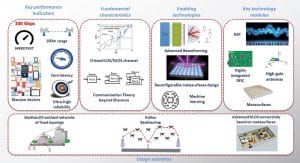Leveraging AI for novel D-band based services


Dr. Edwin Yaqub Prof. Angeliki Alexiou
RapidMiner GmbH University of Piraeus, Research Centre
eyaqub(at)rapidminer.com alexiou(at)unipi.gr


Ralf Klinkenberg Dr.-Ing. Halid Hrasnica
RapidMiner GmbH Eurescom
rklinkenberg(at)rapidminer.com hrasnica(at)eurescom.eu
Systems beyond 5G are set to shift the network communication paradigm, which will heavily affect the information and communication sector. 5G is expected to deliver increased connectivity, highly fault-tolerant communication, and maximum spectral efficiency while keeping latencies at negligible limits. The aspiration is to transform the current 5G wireless thinking from focusing on “local” improvements (e.g. isolating the radio access level or the resource management level) to realizing a vision of pervasive mobile virtual services through network-managing computing and connectivity functions in an integrated way. This beyond 5G transformation envisions bringing together novel radio architectures and an Artificial Intelligence (AI) network approach across various tiers of the technology stack and deployment scenarios.
To address this challenge, multi-disciplinary research teams from industry and academia have joined forces in the Horizon 2020 research project ARIADNE [1], to investigate this link by applying the state of the art in AI and especially Machine Learning (ML) to futuristic beyond 5G scenarios within the D-band frequency range.
ARIADNE’s goal is to bring to fruition the notion of AI-aided D-band wireless beyond 5G networks. This entails the challenges of devising a flexible and powerful ML-based wireless network optimisation framework, introducing novel propagation and channel modelling principles, a revolutionary communication theory approach, and developing cutting-edge technology components (see figure). These include beamforming antenna arrays, reconfigurable metasurfaces based on sophisticated materials, Radio Frequency (RF) frontends, baseband processing, medium access control protocols, ML-based resources and network management, as well as devising a suitable performance evaluation framework defined by the appropriate critical use cases and relevant performance metrics.
Work in ARIADNE includes design of prototypes and simulations to collect data for different scenarios and apply AI to discover complex patterns in data. Up to now, use of AI to optimize key performance indicators (KPIs) and automate decision making has been studied under simplified conditions, whereas ARIADNE aims at reducing this gap while addressing the foundations for an AI-optimized D-band wireless network architecture, which is tested under realistic and sophisticated conditions. In this article, we briefly present some D-band beyond 5G scenarios and justify the need of AI based network management approaches.
D-band beyond 5G scenarios
In ARIADNE, the envisioned beyond 5G applications and attributes focus on three carefully selected representative usage scenarios.
Scenario 1 – Backhaul/Fronthaul networks of fixed topology, where small-cell traffic may be carried over D-band links. In particular, the connectivity between small cells and the network aggregation point could be based on point-to-point, or mesh topologies. In such a scenario, apart from the high targeted aggregate data-rates, the critical system parameters are the transmission range, the capability to establish reliable line-of-sight (LOS) and non-LOS (NLOS) links, the energy efficiency, and the installation cost.
Scenario 2 – Ad-Hoc Backhauling, where moving nodes can serve as gateways (access points) offering backhauling for very high data rate connectivity, in the case of irregular traffic increase (special events), ultra-dense connectivity demands (data ‘shower’) and mobility environment (vehicle traffic management, etc.). Dynamic (ad-hoc) backhaul nodes topology, LOS and multiple hops connectivity (mesh architectures) are the main features of this scenario.
Scenario 3 – Advanced NLOS connectivity based on metasurfaces, where the environment itself is made reconfigurable and can assist the communication between two end-points. For example, randomly distributed environmental objects are coated with reconfigurable intelligent surfaces, e.g., tuneable reflectors, which sense the system’s response to the radio waves and feedback the relevant information. Based on the sensed data, the input and the operation of the object coated with intelligent electromagnetic material are jointly optimized and configured through a software controller.

ARIADNE system concept for AI-based networks beyond 5G
Application of AI and Machine Learning to beyond 5G system challenges
A recent report by Deloitte [5] showed that telecommunications is one of the few industries that is making the highest investment in AI and also reaping the highest Return on Investment (ROI).
In ARIADNE, AI and ML applications are defined within the disciplines of predictive analytics (classification, regression and reinforcement learning methods) and prescriptive analytics (ML-based simulations), which help derive smart and actionable insights. In order to create ML models, the guidance-driven and enterprise-ready approach of RapidMiner [2] is being evaluated in ARIADNE to enable a variety of personas such as analysts, scientists or engineers to efficiently adopt ML.
The list of concrete examples, where ML applications present solutions to ARIADNE scenarios is vast. Examples include:
- Demand forecasting at fronthaul and backhaul during different periods, such as different times of day (considering trend, cycles, seasonality, noise, etc.).
- Resource management in peak and off-peak times: determining smart traffic routes in LOS or NLOS scenarios considering power efficiency, capacity, reliability and other constraints using (ML) model assisted optimization.
- Predicting network congestion or bottlenecks to take pre-emptive corrective measures.
- Predicting various properties of a channel (reliability, latency, signal strength/loss, maximum achievable data rate, degrees of attenuation due to fog, rain and gasses) and environment (direction of user’s movement).
- Predicting a metasurface’s behaviour (angle of reflection, refraction, transmission, signal strength) to decide on optimal unit-cell to be used, reducing initial setup latency by avoiding time-consuming combinatorial optimization.
- Predicting obstruction of the LOS path between mobile receivers and fixed transceivers in a mobile fronthauling scenario.
- Predictive maintenance: predict decline in performance of infrastructure devices (nodes) in backhaul or fronthaul topology, to repair them before they fail.
- Detecting anomalies in traffic patterns to ensure security against malware, fraud, sabotage or other denial of service attacks.
- Business level models: user experience testing of scenarios or service offerings by evaluating KPIs in terms of cost/benefit with and without the use of ML models.
ARIADNE’s approach to Machine Learning
In order to correctly develop and successfully operationalize ML models, the roadmap for ARIADNE carefully considers best practices to avoid common pitfalls in approaching the different disciplines of Machine Learning. In the following we address these in a nutshell.
At the coarse-grained level, business or scientific problems are to be shaped or formulated as Machine Learning problems, for which ARIADNE follows the CRISP-DM analytics methodology [3]. CRISP-DM provides an industry-standard method to identify, define and solve analytics problems. It advocates joint collaboration among subject matter experts and data scientists in various iterative stages, which eventually result in high-quality analytics solutions, which are progressively refined.
Predictive and prescriptive analytics
Predictive Analytics lies at the heart of ML. It involves methods that discover or learn patterns from historical data, which are then applied on new unseen data. Owing to the No Free Lunch theorems [4], modelling is performed using test and trial approaches, using a variety of methods, as no assumptions on a method’s performance can be presumed. In the absence of existing models, firstly, baseline models are developed and subsequently enhanced. Each of the Machine Learning application areas high-quality requires predictive or prescriptive problem solving that is treated on its own merits. But when it comes to ML pipeline creation, ARIADNE follows a design patterns based approach.
These ML design patterns address feature engineering, dimensionality reduction, preventing data contamination, cross-validation, optimizing model parameters, comparison of different models using standard performance metrics (e.g., accuracy, precision or recall for classification problems or various error measures for regression problems, e.g. absolute or relative errors, etc.) or custom performance criteria, such as a reward/loss function or a fitness function to optimize. The objective here is to estimate the performance of a predictive model (robustness) as well as the stability of its performance (deviation) in light of the various use case-specific KPIs.
Some of ARIADNE’s scenarios are broadly classified under Prescriptive Analytics. Engineers often use predictive (or calculation-based) models of physical systems (such as a metasurface) and run simulations to find the optimal input data that produces a desired outcome. Prescriptive Analytics thus helps to understand the decision boundaries of input data, and their impact on the outcome variable. One of its popular uses is the what-if analysis, whose real-time application is foreseen in ARIADNE.
Conclusion
ARIADNE’s holistic approach towards an integrated network managed architecture, where computing and connectivity functions make use of AI and ML, is aiming to improve the future 5G based radio networks at large and meet the highly challenging KPIs defined for beyond 5G scenarios. ARIADNE is committed to disseminating its research results in the broader industrial and academic communities so that ARIADNE’s transformative vision of pervasive mobile virtual services can enlarge its outreach and impact.
References
[1] ARIADNE (EU Horizon 2020 Project). Website: https://www.ict-ariadne.eu
[2] RapidMiner Data Science platform. Website: rapidminer.com
[3] CRISP-DM 1.0 Step-by-step data mining guides, Pete Chapman, Julian Clinton, Randy Kerber, Thomas Khabaza, Thomas Reinartz, Colin Shearer, and Rüdiger Wirth (2000)
[4] No Free Lunch Theorems. Website: http://www.no-free-lunch.org
[5] State of AI in the Enterprise, 2nd Edition, Deloitte Insights (Report), 2018. URL: https://www2.deloitte.com/content/dam/insights/us/articles/4780_State-of-AI-in-the-enterprise/DI_State-of-AI-in-the-enterprise-2nd-ed.pdf